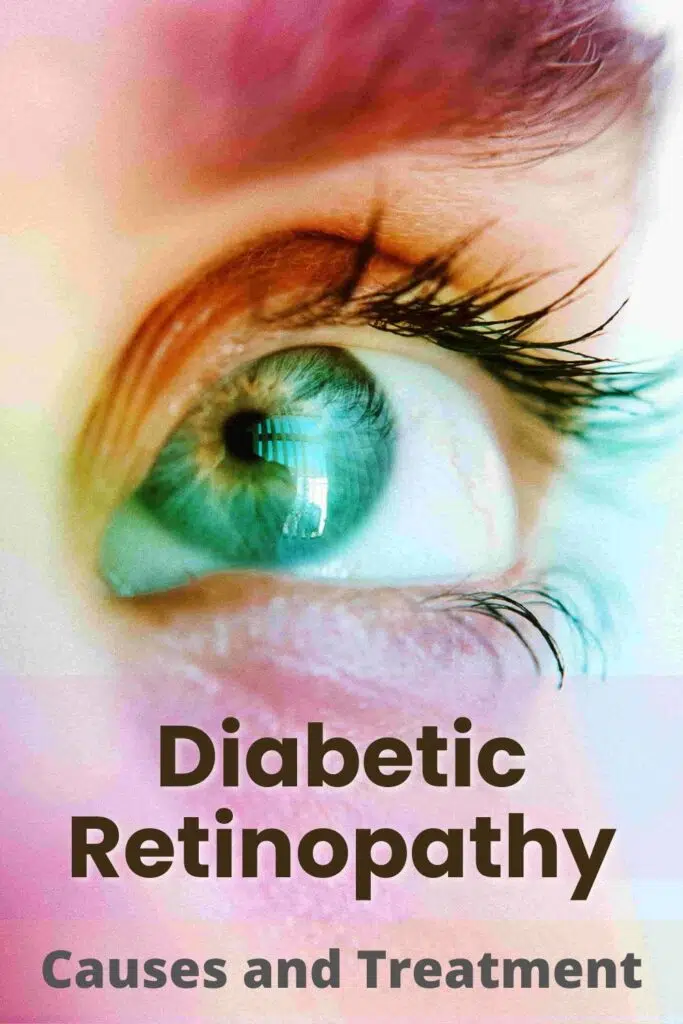In this article, We will look out What is Diabetic Retinopathy as a Complication of Diabetes.
Table of Contents
What is Diabetic Retinopathy
It is an eye disorder that occurs due to the presence of a high level of glucose in the blood that causes damage to the blood vessels of the retina (tissue that senses light). This damaged blood vessels start to swell and leak fluids and blood. This fluid causes the macula (a portion of the eye that is responsible for sharp, clear, straight vision or central vision) to become thick or swell. This is called diabetic macular edema or DME. Various changes occur like loss of blood supply or growth of new blood vessels that can result in vision loss.
What causes Diabetic retinopathy?
It is a long-term effect of Diabetes that can lead to damage to the retina and hence blindness. However, it can be controlled through strict sugar control and early dilated eye exams by an ophthalmologist.
What are the risk factors for diabetic retinopathy?
Let us talk about some factors or determinants associated with an increase in the risk of diabetic neuropathy.
- Age when diabetes is diagnosed in the patient.
- Duration of Diabetes.
- Poor metabolic activity in the body.
- Hypertension or high blood pressure.
- Nephropathy – kidney diseases.
- Others can be smoking, obesity, high cholesterol or fats in the blood, and anemia (decreased RBC count).
What are the Stages of Diabetic retinopathy?
There are four stages of diabetic retinopathy:
- Mild nonproliferative diabetic retinopathy (NPDR)
- Small outpouchings of small blood vessels in the retina are called microaneurysms that can lead to bleeding from the retina.
- Moderate nonproliferative diabetic retinopathy – At least one hemorrhage or macular edema and/or one of the following conditions should be followed
- Retinal bleeding: Black spots in Vision.
- Hard exudate – composed of lipid and protein material that leaks out from impaired blood-retinal barrier and appears as small. white and yellow spots.
- Cotton wool spots – white patches seen on the retina due to damage to the nerve fibers.
- Bleeding from the vein.
- Severe nonproliferative diabetic retinopathy.
- Moderate NPDR and further damage to the retinal blood vessels result in intraretinal bleeding, and abnormalities in large vessels of an eye.
- Diminution of vision
- Proliferative diabetic retinopathy
-
- Neovascularization – natural, abnormal formation of new blood vessels that grow into the retina.
- Vitreous / preretinal hemorrhage – patients usually complain of painless vision loss due to accumulation of blood between two membranes of the vitreous and retina.
-
What is Insulin resistance in Diabetes? Is there any concern?
Treatment for diabetic retinopathy
Laser Treatment:
- Focal laser – This technique burns the microaneurysms(outpouchings of the capillary).
- Grid laser- It is useful to reduce macular edema.
- Pan retinal photocoagulation(PRP).
- Pan retinal photocoagulation is preferred in patients with.
-
-
- Proliferative diabetic retinopathy(PDR)
- High-risk patient
- Early PDR
-
PDR technique burns the part of the retina that have lack blood supply (ischemic) and prevents low levels of oxygen in the blood( hypoxia) By this, secretion of VEGF will be reduced (vascular endothelial growth factor) which plays a role in the formation of new blood vessels and these new vessels were fragile and hence causing bleeding.
Intra Vitreal Injections:
Administer medications in the vitreous humor (jelly-like fluid) layer of an eye.
This will include:
- Anti VEGF injection: It is a human monoclonal antibody that binds with VEGF and leads to its neutralization. Therefore, there will be an absence of neovascularization and leakage. (Study)
- Bevacizumab(Avastin)
- Ranibizumab(Lucentis)
What are the complications of diabetic retinopathy?
Diabetic retinopathy if left untreated, can cause debilitating eye complications such as:
Macular edema
- The weakened wall of the blood vessel in the retina leads to the leakage of fluid in the central part of the retina called the macula which helps in central vision. Macula swells and causes various symptoms like blurriness, and diplopia( double vision).
Vitreous hemorrhage:
- New weakened blood vessels may bleed in the vitreous humor layer of an eye and decrease the passage of light through it which can result in vision loss.
Retinal detachment
- It is a medical emergency that causes leakage of blood and growth of scar tissue. This tissue pulls the retina away from its position and the patient experiences symptoms like flashes of light involving one or both the eyes.
Glaucoma
- It causes damage to the nerve that carries the sensation of vision hence leading to blindness.
What is Insulin resistance in Diabetes? Is there any concern?



